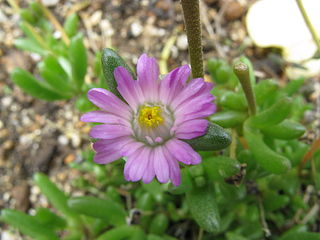
The conservation status of a group of organisms indicates whether the group still exists and how likely the group is to become extinct in the near future. Many factors are taken into account when assessing conservation status: not simply the number of individuals remaining, but the overall increase or decrease in the population over time, breeding success rates, and known threats. Various systems of conservation status exist and are in use at international, multi-country, national and local levels as well as for consumer use.

Mesembryanthemum is a genus of flowering plants in the family Aizoaceae; like many members of this family, it is characterized by long-lasting flower heads. Flowers of Mesembryanthemum protect their gametes from night-time dews or frosts but open in sunlight. There is an obvious evolutionary advantage to doing this; where sun, dew, frost, wind or predators are likely to damage exposed reproductive organs, closing may be advantageous during times when flowers are unlikely to attract pollinators. It is indigenous to southern Africa.

Nicholas Edward Brown was an English plant taxonomist and authority on succulents. He was also an authority on several families of plants, including Asclepiadaceae, Aizoaceae, Labiatae and Cape plants.

An IUCN Red List Critically Endangered species is one that has been categorized by the International Union for Conservation of Nature as facing an extremely high risk of extinction in the wild. As of 2021, of the 120,372 species currently tracked by the IUCN, there are 8,404 species that are considered to be Critically Endangered.
The Namib long-eared bat is a species of vesper bat in the family Vespertilionidae found in Namibia. It is found in dry savanna and temperate desert.
Hypericum quitense is a species of flowering plant in the family Hypericaceae. It is endemic to Ecuador. Its occurs in several types of habitats at elevations between 2,000 and 4,050 meters in the Andes.

Hypericum scopulorum is a species of flowering plant in the family Hypericaceae. It is endemic to Socotra, an island archipelago that is part of Yemen. It is a common plant in shrubland habitat, and it is a dominant species in some areas along with Cephalocroton and another local endemic, Helichrysum rosulatum.

Hypericum socotranum is a species of flowering plant in the Hypericaceae family which is endemic to the island of Socotra in Yemen. Its natural habitats are subtropical or tropical dry forests and rocky areas.

The Aldabra flying fox is a species of megabat in the genus Pteropus. It is endemic to the Aldabra Atoll in the Seychelles, like Chaerephon pusilla, though the latter may be the same species as the little free-tailed bat.
Adiantum fengianum is a species of maidenhair fern endemic to China. Its natural habitat is temperate forests. It is threatened by habitat loss.

Aloe namibensis is a species of plant in the genus Aloe. It is endemic to Namibia. Its natural habitat is rocky areas. It is threatened by habitat loss.
Mesembryanthemum tomentosum, synonyms including Brownanthus pubescens, is a species of plant in the family Aizoaceae. It is native to the Cape Provinces and Namibia. Its natural habitats are dry savanna and rocky areas.

Euphorbia beharensis is a species of plant in the family Euphorbiaceae. It is endemic to Madagascar. Its natural habitats are subtropical or tropical dry forests and subtropical or tropical dry shrubland. It is threatened by habitat loss.

Pararistolochia goldieana is a species of plant in the family Aristolochiaceae. It is found in Cameroon, Equatorial Guinea, Nigeria, and Sierra Leone. Its natural habitat is subtropical or tropical moist lowland forests. It is threatened by habitat loss.
Drimia namibensis is a species of plant that is endemic to Namibia. Its natural habitat is cold desert.
Aleuritopteris albofusca is a species of fern in the family Pteridaceae. It is endemic to China, including Tibet. Its natural habitat is subtropical or tropical dry forests. It is threatened by habitat loss.
Aleuritopteris grevilleoides is a species of fern in the family Pteridaceae. It is endemic to China. Its natural habitat is subtropical or tropical moist lowland forests. It is threatened by habitat loss.

The angulate tortoise is a species of tortoise found in dry areas and coastal scrub vegetation in South Africa. This tortoise is the only known member of the genus Chersina.

Lampranthus tenuifolius, the Narrow-leaf Brightfig, is a critically endangered species of succulent plant that is endemic to the Cape Flats Dune Strandveld around Cape Town, South Africa.

Chondrodactylus angulifer, also known as the common giant ground gecko, the South African ground gecko, or the Namib sand gecko, is a species of gecko, a lizard in the family Gekkonidae. The species is endemic to southern Africa.












